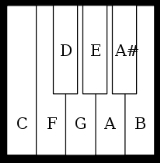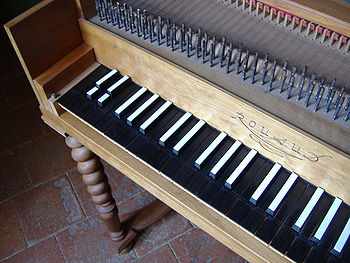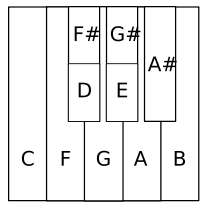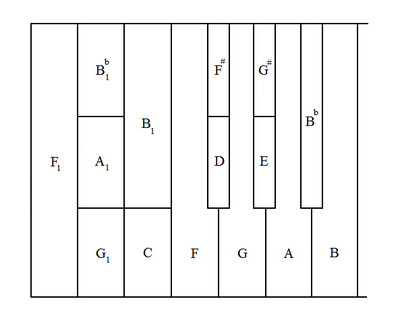
Short octave
Encyclopedia
The short octave was a method of assigning notes to keys in early keyboard instruments (harpsichord
, clavichord
, organ
), for the purpose of giving the instrument an extended range in the bass. A closely related system, the broken octave, is covered below.
E F# G# F G A B C
the player would hear the musical scale
of C major in the bass:
C D E F G A B C
The actual note assignments can be seen in the following diagram, which shows the lowest eight keys of an early keyboard.

The rationale behind this system was that the low notes F# and G# are seldom needed in early music
. Deep bass notes typically form the root
of the chord, and F# and G# chords were seldom used at this time. In contrast, low C and D, both roots of very common chords, are sorely missed if a harpsichord with lowest key E is tuned to match the keyboard layout.
When scholars specify the pitch range of instruments with this kind of short octave, they write "C/E", meaning that the lowest note is a C, played on a key that normally would sound E.
A second type of short octave used the keys B C# D# C D E F# G to play the G major scale G A B C D E F# G. Here, the "exotic" bass notes C# and D# are sacrificed to obtain the more essential G and A. The notation for the pitch range of such an instrument is "G/B".
In stringed instruments like the harpsichord, the short octave system created a defect: the strings which were tuned to mismatch their keyboard notes were in general too short to sound the reassigned note with good tone quality. To reach the lower pitch, the strings had to be thickened, or tuned too slack. During the 17th and 18th centuries, harpsichord builders gradually increased the size and bass range of their instruments, to the point where every bass note could be properly played with its own key.
Short octaves were also sometimes used in the organ
. Here, the practice would not have yielded poor tone quality (since the associated pipes would have to be built with the correct length in any event); nevertheless, because of the loss of musical flexibility they entailed, short octaves ultimately came to be abandoned in organs as well.
, harpsichords and organs of the sixteenth and seventeenth centuries "almost always" had short octaves.
Edward Kottick notes that the short octave persisted for a long time, suggests that a kind of mutual inertia between composers and instrument builders may have been responsible:
A transitional stage toward the final adoption of chromatic keyboards was seen in certain English virginals of the later 17th century. On these the lowest key could pluck two different strings, depends on the slot in which its jack was placed. One of these strings was tuned to low G (the normal pitch of this key in the G/B short octave) and the other to whatever missing chromatic pitch was desired. The player could then move the jack to the slot that provided the desired note, according to the piece being played.
 A variant of the short octave added more notes by using split keys: the front part and the back part of the (visible) key controlled separate levers and hence separate notes. Assume the following keys:
A variant of the short octave added more notes by using split keys: the front part and the back part of the (visible) key controlled separate levers and hence separate notes. Assume the following keys:
E F F# G G# A
with both F# and G# split front to back. Here, E played C, the front half of the F# key played D, and the (less accessible) rear half played F#. The front half of the G# key played E, and the rear half played F#. As with the short octave, the key labeled E played the lowest note C. Thus, playing the nominal sequence
E F# (front) G# (front) F F# (back) G G# (back) A
the player would hear:
C D E F F# G G# A
The actual note assignments can be seen in the following diagram.

It can be seen that only two notes of the chromatic scale, C# and D#, are missing. An analogous arrangement existed for keyboards with G instead of C at the bottom.
According to Trevor Pinnock
, the short octave is characteristic of instruments of the 16th century. He adds, "in the second half of the 17th century, when more accidentals were required in the bass, 'broken octave' was often used."
. The "Viennese bass octave" (German: "Wiener Bass-oktave") lasted well into the second half of the 18th century. Gerlach (2007) describes this keyboard arrangement as follows:
The assignment of notes to keys, which strikingly included a triple-split key, was as shown in the following diagram, adapted from Maunder and Maunder (1998):
 Maunder and Maunder (who use the term "multiple-broken short octave") observe that the Viennese bass octave, like its predecessors, imposed distortions on the string scaling of the harpsichord: it "leads to extreme foreshortening of the scale in the bass." Hence, it required unusually thick strings for the bottom notes, on the order of 0.6 to 0.7 mm.
Maunder and Maunder (who use the term "multiple-broken short octave") observe that the Viennese bass octave, like its predecessors, imposed distortions on the string scaling of the harpsichord: it "leads to extreme foreshortening of the scale in the bass." Hence, it required unusually thick strings for the bottom notes, on the order of 0.6 to 0.7 mm.
The Viennese bass octave gradually went out of style. However, Maunder and Maunder note instruments with Viennese bass octave built even in 1795, and observe that advertisements for such instruments appear even up to the end of the century.
wrote a pavane
in which the left hand plays many parallel tenths. This is a considerable stretch for many players, and become even harder when (as in Philips's pavane), there sometimes other notes included in the chord. Of this piece harpsichord scholar Edward Kottick writes, "The sensuality of effortlessly achieving tenths is so strong, so delightful, that one cannot really claim to know the piece unless it has been played on a short-octave keyboard."
A composer who wrote music conveniently playable only on a broken-octave instrument was Joseph Haydn
, whose early work for keyboard was intended for harpsichord, not piano. As Gerlach (2007) points out, Haydn's "Capriccio in G on the folk song 'Acht Sauschneider müssen sein'", H. XVII:1 (1765) is evidently is written for a harpsichord employing the Viennese bass octave. The work terminates in a chord in which the player's left hand must cover a low G, the G an octave above it, and the B two notes higher still. On orthodox keyboards this would be an impossible stretch for most players, but as on the Viennese bass octave it would have been easy to play, with the fingers depressing keys that visually appeared as D/G/B (see diagram above).
When Haydn's Capriccio was published by Artaria
in the 1780s, the Viennese bass octave had mostly disappeared (indeed, the harpsichord itself was becoming obsolete). The publisher accordingly included alternative notes for the places where the original version could be played only on a short octave instrument, presumably to accommodate the needs of purchasers who owned a harpsichord or piano with the ordinary chromatic bass octave.
Harpsichord
A harpsichord is a musical instrument played by means of a keyboard. It produces sound by plucking a string when a key is pressed.In the narrow sense, "harpsichord" designates only the large wing-shaped instruments in which the strings are perpendicular to the keyboard...
, clavichord
Clavichord
The clavichord is a European stringed keyboard instrument known from the late Medieval, through the Renaissance, Baroque and Classical eras. Historically, it was widely used as a practice instrument and as an aid to composition, not being loud enough for larger performances. The clavichord produces...
, organ
Organ (music)
The organ , is a keyboard instrument of one or more divisions, each played with its own keyboard operated either with the hands or with the feet. The organ is a relatively old musical instrument in the Western musical tradition, dating from the time of Ctesibius of Alexandria who is credited with...
), for the purpose of giving the instrument an extended range in the bass. A closely related system, the broken octave, is covered below.
The short octave
In one variant of the short octave system, the lowest note on the keyboard was nominally E, but the pitch to which it was tuned was actually C. Nominal F# was tuned to D, and nominal G# was tuned to E. Thus, in playing the keys:E F# G# F G A B C
the player would hear the musical scale
Musical scale
In music, a scale is a sequence of musical notes in ascending and descending order. Most commonly, especially in the context of the common practice period, the notes of a scale will belong to a single key, thus providing material for or being used to conveniently represent part or all of a musical...
of C major in the bass:
C D E F G A B C
The actual note assignments can be seen in the following diagram, which shows the lowest eight keys of an early keyboard.

The rationale behind this system was that the low notes F# and G# are seldom needed in early music
Early music
Early music is generally understood as comprising all music from the earliest times up to the Renaissance. However, today this term has come to include "any music for which a historically appropriate style of performance must be reconstructed on the basis of surviving scores, treatises,...
. Deep bass notes typically form the root
Inversion (music)
In music theory, the word inversion has several meanings. There are inverted chords, inverted melodies, inverted intervals, and inverted voices...
of the chord, and F# and G# chords were seldom used at this time. In contrast, low C and D, both roots of very common chords, are sorely missed if a harpsichord with lowest key E is tuned to match the keyboard layout.
When scholars specify the pitch range of instruments with this kind of short octave, they write "C/E", meaning that the lowest note is a C, played on a key that normally would sound E.
A second type of short octave used the keys B C# D# C D E F# G to play the G major scale G A B C D E F# G. Here, the "exotic" bass notes C# and D# are sacrificed to obtain the more essential G and A. The notation for the pitch range of such an instrument is "G/B".
In stringed instruments like the harpsichord, the short octave system created a defect: the strings which were tuned to mismatch their keyboard notes were in general too short to sound the reassigned note with good tone quality. To reach the lower pitch, the strings had to be thickened, or tuned too slack. During the 17th and 18th centuries, harpsichord builders gradually increased the size and bass range of their instruments, to the point where every bass note could be properly played with its own key.
Short octaves were also sometimes used in the organ
Organ (music)
The organ , is a keyboard instrument of one or more divisions, each played with its own keyboard operated either with the hands or with the feet. The organ is a relatively old musical instrument in the Western musical tradition, dating from the time of Ctesibius of Alexandria who is credited with...
. Here, the practice would not have yielded poor tone quality (since the associated pipes would have to be built with the correct length in any event); nevertheless, because of the loss of musical flexibility they entailed, short octaves ultimately came to be abandoned in organs as well.
History
The 18th century author Quirinus van Blankenburg suggested that the C/E short octave originated as an extension of keyboards that went down only to F; the addition of just one key (nominal E) and the reassignment of the F# and G# added three new notes to the bass range. Van Blankenburg says that when the short octave was invented, it was called the "new extension" for this reason. According to Frank HubbardFrank Hubbard
Frank Twombly Hubbard was an American harpsichord maker, a pioneer in the revival of historical methods of harpsichord building.-Student days:...
, harpsichords and organs of the sixteenth and seventeenth centuries "almost always" had short octaves.
Edward Kottick notes that the short octave persisted for a long time, suggests that a kind of mutual inertia between composers and instrument builders may have been responsible:
- Our forebears were much more practical than we are. Since nobody wrote music that required those notes, why go to the expense of putting them in? And what composer would bother to write them if few keyboard instruments had them?
A transitional stage toward the final adoption of chromatic keyboards was seen in certain English virginals of the later 17th century. On these the lowest key could pluck two different strings, depends on the slot in which its jack was placed. One of these strings was tuned to low G (the normal pitch of this key in the G/B short octave) and the other to whatever missing chromatic pitch was desired. The player could then move the jack to the slot that provided the desired note, according to the piece being played.
The broken octave

E F F# G G# A
with both F# and G# split front to back. Here, E played C, the front half of the F# key played D, and the (less accessible) rear half played F#. The front half of the G# key played E, and the rear half played F#. As with the short octave, the key labeled E played the lowest note C. Thus, playing the nominal sequence
E F# (front) G# (front) F F# (back) G G# (back) A
the player would hear:
C D E F F# G G# A
The actual note assignments can be seen in the following diagram.

It can be seen that only two notes of the chromatic scale, C# and D#, are missing. An analogous arrangement existed for keyboards with G instead of C at the bottom.
According to Trevor Pinnock
Trevor Pinnock
Trevor David Pinnock CBE is an English conductor, harpsichordist, and occasional organist and pianist.He is best known for his association with the period-performance orchestra The English Concert which he helped found and directed from the keyboard for over 30 years in baroque and early classical...
, the short octave is characteristic of instruments of the 16th century. He adds, "in the second half of the 17th century, when more accidentals were required in the bass, 'broken octave' was often used."
The Viennese bass octave
The short/broken octave principle not only survived, but was even developed further in one particular location, namely ViennaVienna
Vienna is the capital and largest city of the Republic of Austria and one of the nine states of Austria. Vienna is Austria's primary city, with a population of about 1.723 million , and is by far the largest city in Austria, as well as its cultural, economic, and political centre...
. The "Viennese bass octave" (German: "Wiener Bass-oktave") lasted well into the second half of the 18th century. Gerlach (2007) describes this keyboard arrangement as follows:
- The notes leading down to F1 were accommodated on the keys of a "short-scaled octave" from c to C (only F#1 and G#1, as well as C# and Eb continued to be omitted.
The assignment of notes to keys, which strikingly included a triple-split key, was as shown in the following diagram, adapted from Maunder and Maunder (1998):

The Viennese bass octave gradually went out of style. However, Maunder and Maunder note instruments with Viennese bass octave built even in 1795, and observe that advertisements for such instruments appear even up to the end of the century.
Music written specifically for short-octave instruments
While the short octave seems primarily to have been an economy measure, it does have the advantage that the player's left hand can in certain cases span a greater number of notes. The composer Peter PhilipsPeter Philips
Peter Philips was an eminent English composer, organist, and Catholic priest exiled to Flanders...
wrote a pavane
Pavane
The pavane, pavan, paven, pavin, pavian, pavine, or pavyn is a slow processional dance common in Europe during the 16th century .A pavane is a slow piece of music which is danced to in pairs....
in which the left hand plays many parallel tenths. This is a considerable stretch for many players, and become even harder when (as in Philips's pavane), there sometimes other notes included in the chord. Of this piece harpsichord scholar Edward Kottick writes, "The sensuality of effortlessly achieving tenths is so strong, so delightful, that one cannot really claim to know the piece unless it has been played on a short-octave keyboard."
A composer who wrote music conveniently playable only on a broken-octave instrument was Joseph Haydn
Joseph Haydn
Franz Joseph Haydn , known as Joseph Haydn , was an Austrian composer, one of the most prolific and prominent composers of the Classical period. He is often called the "Father of the Symphony" and "Father of the String Quartet" because of his important contributions to these forms...
, whose early work for keyboard was intended for harpsichord, not piano. As Gerlach (2007) points out, Haydn's "Capriccio in G on the folk song 'Acht Sauschneider müssen sein'", H. XVII:1 (1765) is evidently is written for a harpsichord employing the Viennese bass octave. The work terminates in a chord in which the player's left hand must cover a low G, the G an octave above it, and the B two notes higher still. On orthodox keyboards this would be an impossible stretch for most players, but as on the Viennese bass octave it would have been easy to play, with the fingers depressing keys that visually appeared as D/G/B (see diagram above).
When Haydn's Capriccio was published by Artaria
Artaria
Artaria and company was one of the most important music publishing firms of the late 18th and 19th century. Founded in the 18th century in Vienna, the company is associated with many leading names of the classical era.- History :...
in the 1780s, the Viennese bass octave had mostly disappeared (indeed, the harpsichord itself was becoming obsolete). The publisher accordingly included alternative notes for the places where the original version could be played only on a short octave instrument, presumably to accommodate the needs of purchasers who owned a harpsichord or piano with the ordinary chromatic bass octave.

